Ethyl pyruvate prevents in flammatory factors release and decreases intestinal permeability in rats with D-galactosamine-induced acute liver failure
Wuhan,China
Introduction
Acute liver failure (ALF) is a severe life-threatening condition with a high mortality,and is lack of effective treatment so far[1]Bacterial infection is a major problem in patients with ALF,which may induce acute impairment in systemic circulatory function and hepatorenal syndrome.[2]During the progression of ALF,bacterial overgrowth in the small intestine affects intracellular signal-transduction pathways which lead to the disruption of epithelial tight junctions,and increase the paracellular permeability to macromolecules such as endotoxins.Furthermore,bacteria can translocate to the peritoneal cavity and thus,endotoxemia and spontaneous bacterial peritonitis are generated,thus activating Kupffer cells to release proin flammatory cytokines and resulting in further aggravation of liver failure.[3-5]An intestinal permeability evaluation in patients with ALF might clarify the significance of intestinal permeability in the progression of liver damage and the occurrence of complications that accompany liver failure.[5]Decrease of intestinal permeability would be able to prevent bacteria translocation,suppress endotoxemia and therefore,benefit the recovery of liver injury.
A recent study[6]has shown that high mobility group box-1 (HMGB1) protein is involved in the progression of endotoxemia.HMGB1 can be released into the extracellular milieu from activated macrophages,immuno-stimulated gut epithelial cells and necrotic or damaged cells in a delayed manner relative to the secretion of tumor necrosis factor-alpha (TNF-α) and interleukin-1(IL-1).[7]HMGB1 contributes to the pathogenesis of many diverse in flammatory disorders.[8-10]Therefore,it is believed that HMGB1 as an important in flammatory mediator of endotoxemia may also play a significant role in the changes of intestinal permeability in ALF.
Ethyl pyruvate (EP),a simple aliphatic ester derived from pyruvic acid,has been shown to improve survival and ameliorate organ dysfunction in a variety of animal models of critical illness,including acute endotoxemia,[11]polymicrobial bacterial sepsis,[12]postsurgical ileus,[13]burn injury,[14]acute pancreatitis,[15]organ ischemia and reperfusion injury,[16]and hemorrhagic shock.[17]Our previous study[18]has demonstrated that EP is able to treat or prevent liver failure effectively by suppressing the release of proin flammatory cytokines in rats.
Using ALF model in rats,we evaluated the effect of endotoxemia,HMGB1 and multiple proin flammatory cytokines on ALF,explored the relations among endotoxin,HMGB1 and intestinal permeability,and investigated whether EP administration could prevent the release of proin flammatory cytokines and protect the increase of intestinal permeability in ALF rats.
Methods
Animal models
Male Wistar rats of specific-pathogen-free (SPF),weighing 180-220 g,were purchased from the Experimental Animal Center of Wuhan University.The rats were acclimated to the animal research laboratory for 5 days before experiments and were maintained in a light-controlled room (12-hour light/dark cycle) at an ambient temperature of 25 ℃ with free access to water and standard rat chow.All rats were given humane care in accordance with the institutional guidelines.
ALF in the rats was induced by intraperitoneal injection of D-galactosamine (purity of 98%,Nanjing Debao Biochemical Equipment Co.,Ltd,Jiangsu,China)at a dose of 1.2 g/kg.D-galactosamine was freshly dissolved in physiologic saline and adjusted to pH 6.8 with 1 mol/L NaOH.After injection,the rats had free access to food and water until end point.
Experimental design
Ninety-six animals were randomly divided into control(saline,i.p,n=18),model (D-galactosamine,1.2 g/kg,n=26),prevention [EP injection (40 mg/kg) 2 hours ahead of D-galactosamine,n=26] and treatment groups(EP injection 2 hours after D-galactosamine,n=26).EP was dissolved in Ringer's solution (Na+130 mmol/L,K+4 mmol/L,Ca2+2.7 mmol/L,Cl-139 mmol/L,EP 28 mmol/L,pH=7.02 and injected intravenously.[19,20]The rats of the model group were injected intravenously with the same volume of Ringer's solution at 2 hours after ALF induction.
Sample collection
One set of 8 rats from the four groups were sacrificed for blood,liver and intestinal tissue collection at 12 hours after ALF induction.Another set were sacrificed at 24 hours after ALF induction.The remaining 10 rats in the model group,EP prevention group and EP treatment group,and 2 rats in the control group were observed for survival every 12 hours for 7 days after induction of ALF.
Histological determinations
Some portions of liver and intestinal samples werefixed in 10% buffered formalin for 24 hours,embedded in paraffin,sliced into sections of 5 μm thickness and stained with hematoxylin and eosin (HE) to evaluate the pathological changes under a light microscope.The other portions of the liver and intestinal specimens werefixed in 2.5% glutaraldehyde,embedded in epoxy resin,sliced into ultrathin sections (60 nm thicknesses)and stained with uranyl acetate and lead citrate to observe the ultrastructural changes of tissue under a transmission electron microscope.Histological evaluation was performed by two blinded pathologists.Intestinal mucosal damage was graded from 0 to 5 according to the standard scale of Chiu et al.[21]Brie fly,grading was performed and classified as:0=normal mucosa; 1=development of subepithelial space at the tip of the villus; 2=extension of the subepithelial space with moderate epithelial lifting; 3=massive epithelial lifting;4=denuded villi; 5=disintegration of the lamina propria.
Blood samples assay
Serum alanine aminotransferase (ALT) was determined by routine biochemical methods using a Hitachi Automatic Analyzer (Hitachi,Inc.Japan).Serum endotoxin was assayed by Limulus Amebocyte Lysate methods using a commercial kit (LAL,QCL-1000 ?,BioWhittaker,USA).The serum of D(-)-lactate was measured by the enzymatic-spectrophotometric method.[22]Serum diamine oxidase (DAO) was detected by the o-diamisidine reagent method.[23]Serum HMGB1 was measured using a rat HMGB1 ELISA Kit(Wuhan EIAab Science Co.,Ltd,China) according to the manufacturer's instructions.Serum TNF-α and IFN-γ were measured by ELISA using a commercial kit (Jingmei Biotech Co.,Ltd,China) according to the manufacturer's protocols.
Statistical analysis
All data were expressed as mean±SD.Differences among the groups were assessed using Student's t test and one-way ANOVA.The degree of association between intestinal permeability parameters and proin flammatory cytokines was assessed with Pearson's product-moment correlation coefficient.Animal survival data were evaluated using the Kaplan-Meier method and compared with the log-rank test.SPSS 13.0 for Windows was used for statistical analysis.A P value less than 0.05 was considered to be statistically significant.
Results
EP improves the liver histology of ALF
HE staining showed that liver tissue from the control group was normal (Fig.1G).The liver tissue from the model group showed cytoplasm osteoporosis,eosinophilic degeneration and infiltration of in flammatory cells at 12 hours after ALF induction.These changes worsened at 24 hours with the disorder of hepatic lobules with infiltration of many periportal in flammatory cells,hepatic plate dissociation,swelling or lytic necrosis of hepatocytes (Fig.1A,D).Compared with the model group,liver histology was significantly improved in EP prevention and treatment groups at 12 and 24 hours after ALF induction,indicating a marked decrease of in flammatory cell infiltration,wellarranged hepatic cord,alleviation of hepatocytes swelling,and less pyrenolysis (Fig.1B,C,E,F).
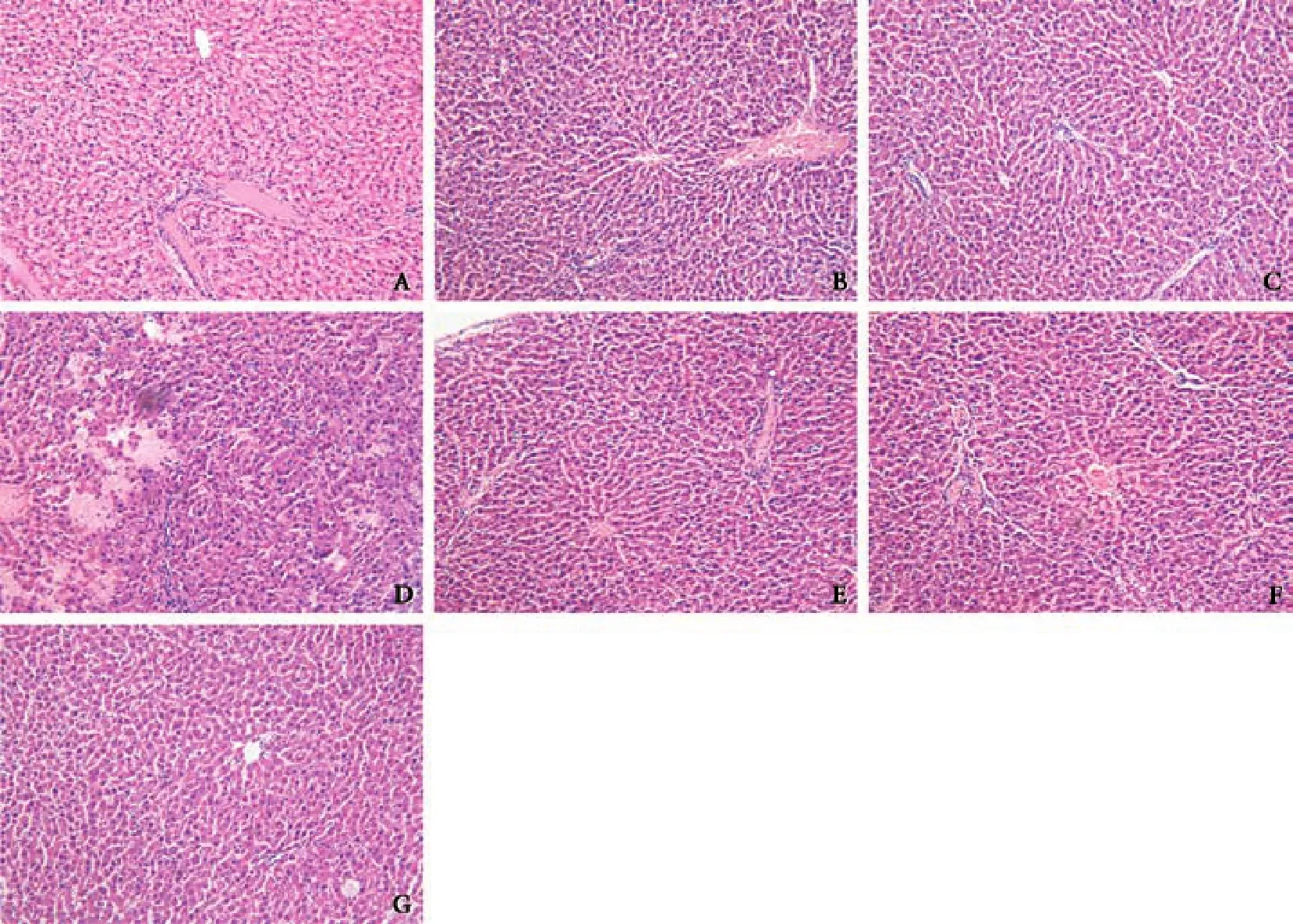
Fig.1.A representative image of liver tissue with HE staining (original magnification ×200).A:model group at 12 hours; B:EP prevention group at 12 hours; C:EP treatment group at 12 hours; D:model group at 24 hours; E:EP prevention group at 24 hours ; F:EP treatment group at 24 hours; G:control group.
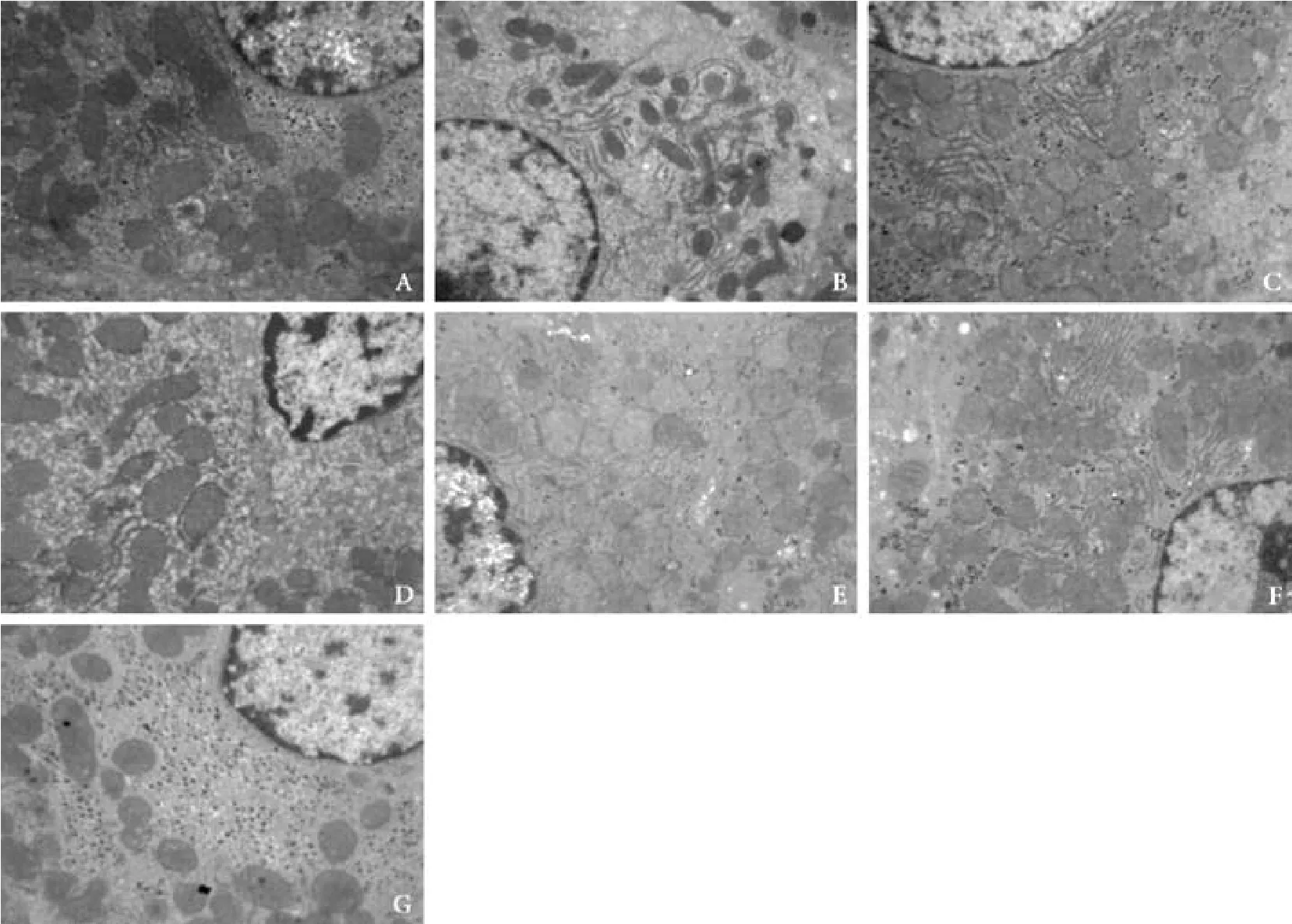
Fig.2.A representative image of liver tissue by an electronic microscope (original magnification ×10 000).A:model group at 12 hours; B:EP prevention group at 12 hours; C:EP treatment group at 12 hours; D:model group at 24 hours; E:EP prevention group at 24 hours; F:EP treatment group at 24 hours; G:control group.
Electronic microscopy showed that the hepatocytes ultrastructure was normal in the control group (Fig.2G),and cells from the model group showed that glycogen granules decreased obviously in cytolymph and mitochondrion was swollen 12 hours after ALF induction (Fig.2A).A more severe cell injury presented at 24 hours after ALF induction,showing dilated or broken endoplasmic reticulum,lysed mitochondrial cristae,vanishing chromatin,and vacuolized nuclei (Fig.2D).The ultrastructure of hepatocytes was significantly improved in the EP prevention and treatment groups as compared with the model group.This finding indicated that dilation of endoplasmic reticulum and swelling of mitochondria were alleviated obviously,with clear mitochondrial cristae and membrane,symmetrical chromatin,and legible nucleoli and nuclear membrane(Fig.2B,C,E,F).
EP protecting the intestinal mucosa of ALF
HE staining showed normal intestinal mucosa in the control group.Intestinal villi were integrated without epithelial cells edema (Fig.3G).Whereas in the model group,intestinal epithelial cells were swelling and central lacteal was expanded at 12 hours after ALF induction.A more severe injury to intestinal mucosa presented at 24 hours after ALF induction,indicating that the structure of intestinal mucosa was in disorder with edema and necrosis of epithelial cells,and that the central lacteal was highly expanded with structural damage of villus (Fig.3A,D).Intestinal histology was significantly improved in the EP prevention and treatment groups at 12 and 24 hours after ALF induction,showing alleviated swelling of intestinal mucosa,less expansion of central lacteal,and well-arranged structure of villus (Fig.3B,C,E,F).The pathological grades of intestinal injury in the model group were significantly higher than those in the control group (P<0.01) (Fig.3H).The pathological grades in the EP prevention and treatment groups at both 12 and 24 hours after ALF induction were significantly lower than those of the model group (P<0.05).
The ultrastructure of intestinal mucosa was normal in the control group (Fig.4G) at 12 and 24 hours after ALF induction.Intestinal mucosa showed microvilli swelling,loosed cellular connection,condensed cell nuclei,and cell apoptosis.(Fig.4A,D).The ultrastructure of intestinal mucosa was significantly improved in the rats of EP prevention and treatment groups as compared with the model group:alleviated microvilli swelling,close cellular connection,and symmetrical chromatin (Fig.4B,C,E,F).
Intestinal permeability correlated to the release of proin flammatory cytokines
Statistical analysis showed that in the model group,there was a positive correlation among serum D(-)-lactate and HMGB1 (r=0.975,P<0.001); D(-)-lactate and TNF-α (r=0.979,P<0.001); DAO and HMGB1 (r=0.925,P<0.001) and DAO and TNF-α (r=0.969,P<0.001).These results suggested that intestinal permeability(indicted by D(-)-lactate and DAO) is strongly correlated with the release of proin flammatory cytokines.
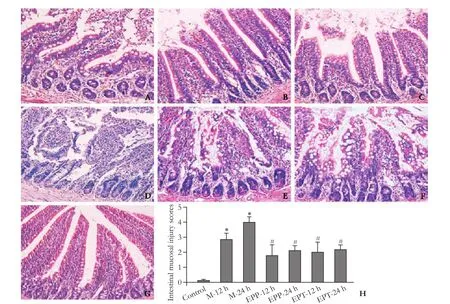
Fig.3.Histological changes in intestinal mucosa after induction of ALF with/without treatment with EP (HE,original magnification ×200).A:model group at 12 hours ; B:EP prevention group at 12 hours; C:EP treatment group at 12 hours; D:model group at 24 hours;E:EP prevention group at 24 hours ; F:EP treatment group at 24 hours; G:control group; H:intestinal pathological injury scores.*:P<0.05,vs control group; #:P<0.05,vs model group.M:model group; EPP:EP prevention group; EPT:EP treatment group.

Fig.4.A representative image of intestinal mucosa tissue by an electronic microscope (original magnification ×3000).A:model group at 12 hours; B:EP prevention group at 12 hours; C:EP treatment group at 12 hours; D:model group at 24 hours; E:EP prevention group at 24 hours; F:EP treatment group at 24 hours; G:control group.
EP decreases the serum ALT,HMGB1,TNF-α and IFN-γ
Serum ALT,HMGB1,TNF-α and IFN-γ were significantly increased in the model group at 12 and 24 hours after ALF induction compared with the control group (P<0.05) (Fig.5).EP significantly decreased serum ALT,HMGB1,TNF-α and IFN-γ in both prevention and treatment groups 12 and 24 hours after ALF induction (P<0.05).

Fig.5.Effects of EP on serum ALT (A),HMGB1 (B),TNF-α (C)and IFN-γ (D) levels in the rats with ALF.#:P<0.05,vs control group; *:P<0.05,vs model group at 12 hours; ^:P<0.05,vs model group at 24 hours.M:model group; EPP:EP prevention group;EPT:EP treatment group.
EP protecting intestinal permeability
Serum endotoxin,D(-)-lactate and DAO were significantly increased in the model group 12 and 24 hours after ALF induction compared with the control group (P<0.05) (Fig.6).EP significantly decreased these markers of intestinal permeability in both EP prevention and treatment groups (P<0.05).
EP prolonging the median survival time of ALF rats
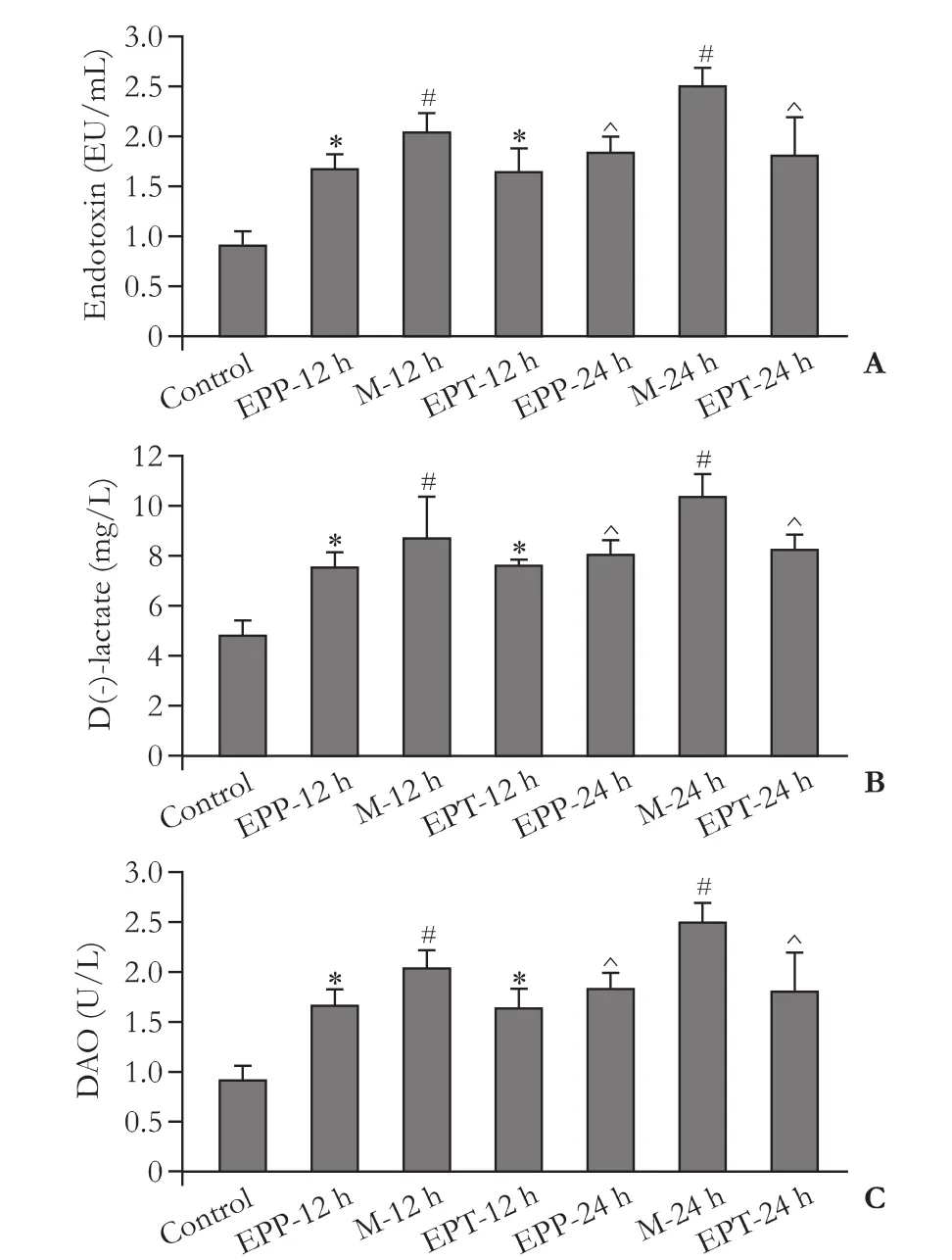
Fig.6.Effects of EP on serum endotoxin (A),D(-)-lactate (B) and DAO (C) levels in rats with ALF.#:P<0.05,vs control group; *:P<0.05,vs model group at 12 hours; ^:P<0.05,vs model group at 24 hours.M:model group; EPP:EP prevention group; EPT:EP treatment group.
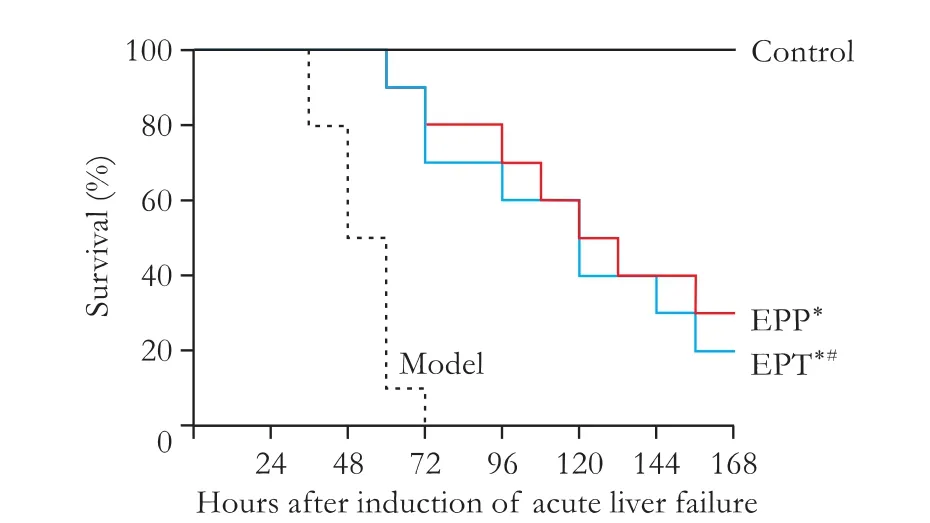
Fig.7.Effects of EP on survival of rats with ALF.*:P<0.01,vs model group; #:P>0.05,vs EPP.EPP:EP prevention group; EPT:EP treatment group.
Survival curves of each group are shown in Fig.7.The ALF rats died within 3 days,and their median survival time was 54 hours.The rat median survival time in the EP prevention and treatment groups were 126 and 120 hours,respectively.The log-rank test demonstrated that there was a significant difference in the curves (χ2=38.65,P<0.0001).
Discussion
It is believed that the pathogenesis of liver failure is related to "primary liver injury" induced directly or indirectly (i.e.immunopathological damage) by hepatitis virus or other etiological factors; and "secondary liver injury" induced by the intestinal endotoxemia and the release of proin flammatory cytokines such as TNF-α.[5]Intestinal endotoxemia,resulted from overgrowth and translocation of bacteria from the gut into peritoneal cavity due to the increased permeability of intestinal wall,plays a significant role in the progresses of liver failure.[4,5]In the present study,we evaluated the histological changes of intestinal tissue and serological changes of cytokines,endotoxin,D(-)-lactate and DAO in a rat model of ALF induced by D-galactosamine.The rats in the model group presented severe pathological changes in intestinal mucosa at 12 and 24 hours after ALF induction,mainly swelling and necrosis of epithelial cells,disorder of intestinal mucosa structure,and highly expanded central lacteal.The intestinal pathological injury scores in the model group were significantly higher than those in the control group.Moreover,serum endotoxin was significantly increased.These results suggested that liver failure could increase intestinal permeability and cause endotoxemia which may,in turn,further aggravate liver damage.Therefore,treatment of liver failure may block this vicious circle.
EP is a synthesized form of pyruvate and ethanol and is stable in Ringer's ethyl pyruvate solution (REPS)through interactions with calcium and potassium ions.[24]Treatment with EP has been shown to be beneficial in animal models of a variety of acute and chronic in flammatory conditions.[11-17]Our study[18]demonstrated that EP improved survival in rats with liver failure,and that EP is a potential novel therapeutic agent for severe liver injury.Intestinal permeability is defined as certain molecules pass through intestinal mucosa by simple diffusion.Normal intestinal permeability is crucial for the maintenance of intestinal barrier and the prevention of endotoxemia.[25]Studies[26-30]reported the salutary effect of EP on gut barrier function in different acute injury models,including hemorrhagic shock,intestinal ischemia/reperfusion,endotoxemic,and acute alcoholic liver injury.In the present study,an ALF animal model induced by D-galactosamine was employed.We aimed to further explore the protective effects of EP on intestinal permeability in rats with ALF.
This study showed that EP significantly protects the liver from injury and improves liver histopathology and survival of ALF rats.More importantly,EP also improves intestinal histopathology regardless of prevention before or treatment after ALF induction,while alleviating swelling of intestinal mucosa,lowering expansion of central lacteal,and well-arrangement of villus structure.Moreover,EP significantly reduces serum endotoxin.These findings suggest that EP effectively prevent the increase of intestinal permeability and the generation of endotoxemia in ALF rats.
To further evaluate the effects of EP on intestinal permeability,serum D(-)-lactate and DAO were also detected in the present study.D(-)-lactate,a metabolite of bacteria in the gastrointestinal tract,can not be metabolized rapidly in the body because of lack of necessary enzymes.So D(-)-lactate is a sensitive parameter to re flect intestinal permeability.[31]DAO primarily exists in the intestinal villi of mammalians.Serum DAO re flects intestinal mucosal barrier function.[32]Previously,we found that serum D-lactate and DAO could be used as sensitive indicators for early diagnosis of injury to intestinal mucosa.[33]In the present study,serum D(-)-lactate and DAO were significantly increased in the model group compared with the control group.EP significantly decreases serum D(-)-lactate and DAO regardless of administration before or after ALF induction.These results showed that EP could reduce intestinal permeability.
A recent study[34]has shown that the release of in flammatory cytokines is also one of the important mechanisms for the pathogenesis of ALF.As the representatives of cytokines,serum HMGB1 and TNF-α were evaluated and their correlation with intestinal permeability was also analyzed.We found that serum HMGB1 and TNF-α were significantly increased in the model group compared with the control group.There were positive correlations among D(-)-lactate,DAO,HMGB1,and TNF-α.These findings suggested that intestinal permeability is strongly correlated with the release of proin flammatory cytokines.The release of cytokines and the increase of intestinal permeability might in fluence each other.The results of this study also revealed that EP administration before or after ALF induction significantly decreased serum HMGB1,TNF-α and IFN-γ,thus preventing the increase of intestinal permeability via suppressing the release of cytokines in ALF rats.
Although EP ameliorated liver injury and decreased intestinal permeability,there was a significant mortality(80% on day 7) in the groups treated with EP.The reason is that the rats in the prevention and treatment groups were administered with EP only once,which did not completely block the progress of liver injury.However,EP indeed significantly prolonged the median survival time.Multiple administration of EP probably decreases the mortality in ALF rats,which can be explored in the future study.
In summary,the present study demonstrated that D-galactosamine increased intestinal permeability,which was strongly correlated with the release of proin flammatory cytokines.EP administration protected liver and intestinal mucosa from injury,decreased intestinal permeability and endotoxemia,inhibited the release of HMGB1 and other cytokines in rats with ALF,andfinally improved the survival of ALF rats.
Contributors:WLK proposed the study.WLW wrote the first draft.WLK,WLW,LX and HXQ collected and analyzed the data.All authors contributed to the design and interpretation of the study and to further drafts.GZJ is the guarantor.
Funding:This study was supported by a grant from the National Natural Science Foundation of China (81071342).
Ethical approval:The study was approved by the Renmin Hospital of Wuhan University Medical Ethics Committee.
Competing interest:No benefits in any form have been received or will be received from a commercial party related directly or indirectly to the subject of this article.
1 Lee WM.Acute liver failure.Semin Respir Crit Care Med 2012;33:36-45.
2 Lenz K,Kapral C,Gegenhuber A,Buder R,Wewalka F.Systemic,renal,and hepatic hemodynamic derangement in cirrhotic patients with spontaneous bacterial peritonitis.Hepatology 2004;39:865-867.
3 Chen C,Li L,Wu Z,Chen H,Fu S.Effects of lactitol on intestinal micro flora and plasma endotoxin in patients with chronic viral hepatitis.J Infect 2007;54:98-102.
4 Li L,Wu Z,Ma W,Yu Y,Chen Y.Changes in intestinal micro flora in patients with chronic severe hepatitis.Chin Med J (Engl) 2001;114:869-872.
5 Han DW.Intestinal endotoxemia as a pathogenetic mechanism in liver failure.World J Gastroenterol 2002;8:961-965.
6 Yang H,Tracey KJ.Targeting HMGB1 in in flammation.Biochim Biophys Acta 2010;1799:149-156.
7 Wang H,Bloom O,Zhang M,Vishnubhakat JM,Ombrellino M,Che J,et al.HMG-1 as a late mediator of endotoxin lethality in mice.Science 1999;285:248-251.
8 Sha Y,Zmijewski J,Xu Z,Abraham E.HMGB1 develops enhanced proin flammatory activity by binding to cytokines.J Immunol 2008;180:2531-2537.
9 Rouhiainen A,Tumova S,Valmu L,Kalkkinen N,Rauvala H.Pivotal advance:analysis of proin flammatory activity of highly purified eukaryotic recombinant HMGB1 (amphoterin).J Leukoc Biol 2007;81:49-58.
10 Kokkola R,Andersson A,Mullins G,Ostberg T,Treutiger CJ,Arnold B,et al.RAGE is the major receptor for the proin flammatory activity of HMGB1 in rodent macrophages.Scand J Immunol 2005;61:1-9.
11 Hauser B,Kick J,Asfar P,Ehrmann U,Albicini M,Vogt J,et al.Ethyl pyruvate improves systemic and hepatosplanchnic hemodynamics and prevents lipid peroxidation in a porcine model of resuscitated hyperdynamic endotoxemia.Crit Care Med 2005;33:2034-2042.
12 Zhang Y,Li M,Meng M,Qin C.Effect of ethyl pyruvate on physical and immunological barriers of the small intestine in a rat model of sepsis.J Trauma 2009;66:1355-1364.
13 Harada T,Moore BA,Yang R,Cruz RJ Jr,Delude RL,Fink MP.Ethyl pyruvate ameliorates ileus induced by bowel manipulation in mice.Surgery 2005;138:530-537.
14 Wang WJ,Yao YM,Xian LM,Dong N,Yu Y.Effect of treatment with ethyl pyruvate on multiple organ dysfunction and mortality following delayed resuscitation after burn injury in rat.Zhongguo Wei Zhong Bing Ji Jiu Yi Xue 2006;18:132-135.
15 Cheng BQ,Liu CT,Li WJ,Fan W,Zhong N,Zhang Y,et al.Ethyl pyruvate improves survival and ameliorates distant organ injury in rats with severe acute pancreatitis.Pancreas 2007;35:256-261.
16 Unal B,Karabeyoglu M,Huner T,Canbay E,Eroglu A,Yildirim O,et al.Ethyl pyruvate protects colonic anastomosis from ischemia-reperfusion injury.Surg Innov 2009;16:21-25.
17 Fink MP.Reactive oxygen species as mediators of organ dysfunction caused by sepsis,acute respiratory distress syndrome,or hemorrhagic shock:potential benefits of resuscitation with Ringer's ethyl pyruvate solution.Curr Opin Clin Nutr Metab Care 2002;5:167-174.
18 Wang LW,Wang LK,Chen H,Fan C,Li X,He CM,et al.Ethyl pyruvate protects against experimental acute-on-chronic liver failure in rats.World J Gastroenterol 2012;18:5709-5718.
19 Lee J,Kwon W,Jo Y,Suh G,Youn Y.Protective effects of ethyl pyruvate treatment on paraquat-intoxicated rats.Hum Exp Toxicol 2008;27:49-54.
20 Karabeyo?lu M,Unal B,Bozkurt B,Dolap?i I,Bilgihan A,Karabeyo?lu I,et al.The effect of ethyl pyruvate on oxidative stress in intestine and bacterial translocation after thermal injury.J Surg Res 2008;144:59-63.
21 Chiu CJ,McArdle AH,Brown R,Scott HJ,Gurd FN.Intestinal mucosal lesion in low- flow states.I.A morphological,hemodynamic,and metabolic reappraisal.Arch Surg 1970;101:478-483.
22 Murray MJ,Barbose JJ,Cobb CF.Serum D(-)-lactate levels as a predictor of acute intestinal ischemia in a rat model.J Surg Res 1993;54:507-509.
23 Hosoda N,Nishi M,Nakagawa M,Hiramatsu Y,Hioki K,Yamamoto M.Structural and functional alterations in the gut of parenterally or enterally fed rats.J Surg Res 1989;47:129-133.
24 Wang P,Gong G,Wei Z,Li Y.Ethyl pyruvate prevents intestinal in flammatory response and oxidative stress in a rat model of extrahepatic cholestasis.J Surg Res 2010;160:228-235.
25 Aldersley MA,Howdle PD.Intestinal permeability and liver disease.Eur J Gastroenterol Hepatol 1999;11:401-403.
26 Tawadrous ZS,Delude RL,Fink MP.Resuscitation from hemorrhagic shock with Ringer's ethyl pyruvate solution improves survival and ameliorates intestinal mucosal hyperpermeability in rats.Shock 2002;17:473-477.
27 Sims CA,Wattanasirichaigoon S,Menconi MJ,Ajami AM,Fink MP.Ringer's ethyl pyruvate solution ameliorates ischemia/reperfusion-induced intestinal mucosal injury in rats.Crit Care Med 2001;29:1513-1518.
28 Yang R,Zou X,Koskinen ML,Tenhunen J.Ethyl pyruvate reduces liver injury at early phase but impairs regeneration at late phase in acetaminophen overdose.Crit Care 2012;16:R9.
29 Sappington PL,Han X,Yang R,Delude RL,Fink MP.Ethyl pyruvate ameliorates intestinal epithelial barrier dysfunction in endotoxemic mice and immunostimulated caco-2 enterocytic monolayers.J Pharmacol Exp Ther 2003;304:464- 476.
30 Yang R,Han X,Delude RL,Fink MP.Ethyl pyruvate ameliorates acute alcohol-induced liver injury and in flammation in mice.JLab Clin Med 2003;142:322-331.
31 Marcos MA,Vila J,Gratacos J,Brancos MA,Jimenez de Anta MT.Determination of D-lactate concentration for rapid diagnosis of bacterial infections of body fluids.Eur J Clin Microbiol Infect Dis 1991;10:966-969.
32 Takagi K,Nakao M,Ogura Y,Nabeshima T,Kunii A.Sensitive colorimetric assay of serum diamine oxidase.Clin Chim Acta 1994;226:67-75.
33 Ruan P,Gong ZJ,Zhang QR.Changes of plasma D(-)-lactate,diamine oxidase and endotoxin in patients with liver cirrhosis.Hepatobiliary Pancreat Dis Int 2004;3:58-61.
34 Sass G,Heinlein S,Agli A,Bang R,Schümann J,Tiegs G.Cytokine expression in three mouse models of experimental hepatitis.Cytokine 2002;19:115-120.
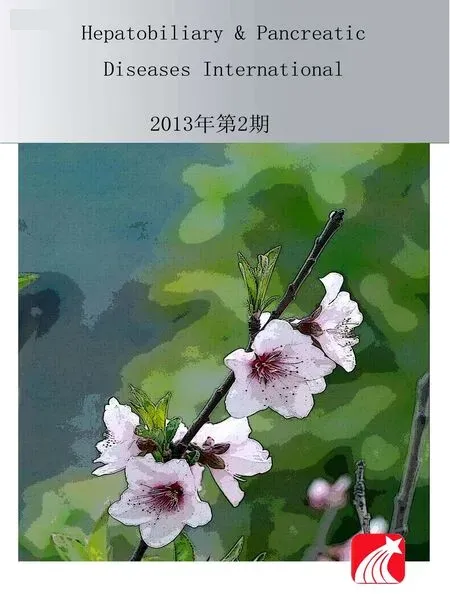 Hepatobiliary & Pancreatic Diseases International2013年2期
Hepatobiliary & Pancreatic Diseases International2013年2期
- Hepatobiliary & Pancreatic Diseases International的其它文章
- Technical note on complete excision of choledochal cysts
- Risk factors of choledocholithiasis formation after liver transplantation
- Hepaticojejunostomy with the "Hand-Fan" technique
- Values of circulating GPC-3 mRNA and alpha-fetoprotein in detecting patients with hepatocellular carcinoma
- Management hepatolithiasis with operative choledochoscopic FREDDY laser lithotripsy combined with or without hepatectomy
- Short-term entecavir versus lamivudine therapy for HBeAg-negative patients with acute-onchronic hepatitis B liver failure
